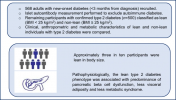Eddy Edson
Well-Known Member
- Relationship to Diabetes
- Type 2
... in a Ugandan population.

 link.springer.com
link.springer.com


Understanding the pathogenesis of lean non-autoimmune diabetes in an African population with newly diagnosed diabetes - Diabetologia
Aims/hypothesis Apparent type 2 diabetes is increasingly reported in lean adult individuals in sub-Saharan Africa. However, studies undertaking robust clinical and metabolic characterisation of lean individuals with new-onset type 2 diabetes are limited in this population. This cross-sectional...
Conclusions/interpretation
Approximately one-third of participants with incident adult-onset non-autoimmune diabetes had BMI <25 kg/m2. Diabetes in these lean individuals was more common in men, and predominantly associated with reduced pancreatic secretory function rather than insulin resistance. The underlying pathological mechanisms are unclear, but this is likely to have important management implications.
